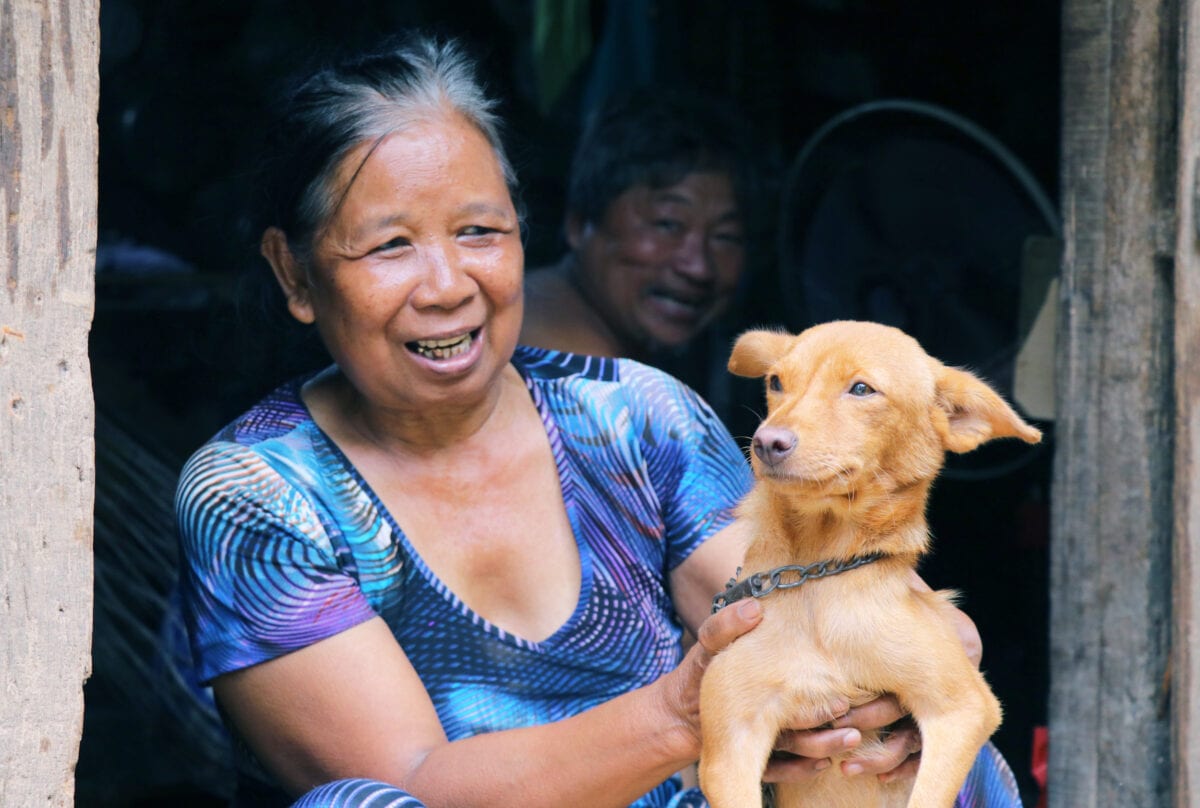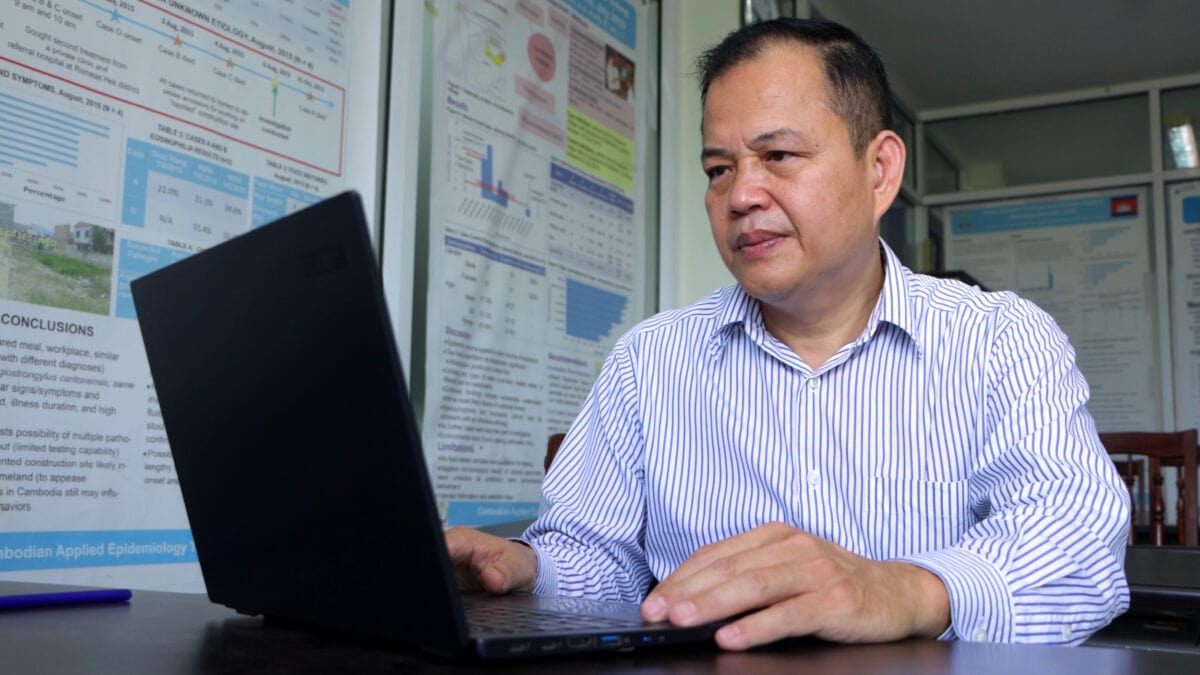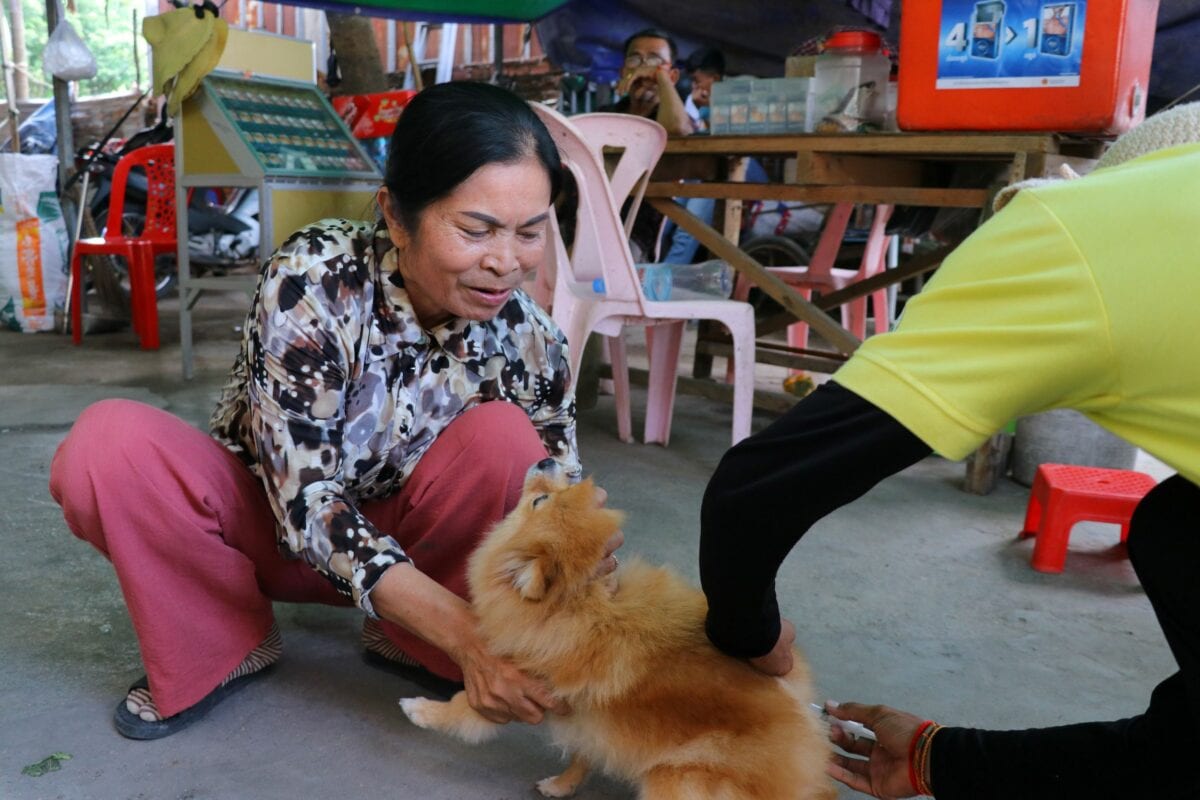What does it take to put One Health into practice?
A rabies prevention and control project in Cambodia tests out new ways of doing public health
Every year as many as 800 Cambodians die of rabies following dog bites. Breaking the cycle of disease is possible, but only when human and animal health workers join forces. A German-supported project is working with Cambodian partners to jointly implement rabies activities in the public sector for the first time.
On the trail of rabies in Battambang Province
Every day, Chiloeurn Chhoeurn, a surveillance officer with the Battambang Provincial Health Department, comes to work and does a job that no one in her part of Cambodia has ever done before. From her small office, hosted at the Battambang Rabies Prevention Center run by the Institut Pasteur du Cambodge, she reviews the cases of patients who have sought medical care or vaccination against rabies following a dog bite and alerts a team at the Provincial Office of Animal Health and Production about high-risk incidents which require investigation.

A dog which has bitten one person could well bite others, so finding and testing the dog – quickly – is critical to prevent further harm. It is also vital for surveillance. Rabies is endemic in Battambang and across the rest of Cambodia, but solid data about its extent remain scant. Preventing and eventually eliminating rabies – as well as other diseases with zoonotic origins – will only be possible if human and animal health workers are in the habit of working together. Armed with a cell phone, a computer, and a lot of perseverance, Chiloeurn Chhoeurn is doing her part to help integrate the work of two health systems which – despite the rise in zoonotic threats with pandemic potential – still operate largely in parallel.
A neglected zoonotic disease
Before February 2023, when Chiloeurn Chhoeurn began coordinating Integrated Bite Case Management (IBCM) in Battambang, there was no formal linkage between human and animal health workers when it came to rabies prevention and control in the province. Dog bite incidents reported within the human health system did not trigger any investigations by animal health workers. The systems were not in place to capture and communicate this information, nor did staff at the Provincial Office of Animal Health and Production have the necessary training or budget to undertake rabies control measures.

The same was broadly true in the rest of the country. Even though an estimated 375,000 people are bitten by dogs in Cambodia every year, and as many as 800 subsequently die of rabies, the disease receives relatively little attention. Rabies is a classic ‘neglected zoonotic disease’ – one which inflicts a constant economic and social burden on poor communities but is rarely tracked by formal surveillance systems. As a result, its incidence and impact are largely unknown, awareness about the disease remains low, and proven measures for preventing and controlling its spread are not prioritised.
Although the tools and technologies to prevent human deaths from dog-mediated rabies are well established, and the ’playbook’ for eventually eliminating it is clear, people in Cambodia continue to lose their lives to a disease which is always fatal once symptoms appear – but 100 percent preventable if vaccination is administered in time following exposure.
A new One Health project joins up the dots
This situation may be starting to change, thanks in part to a project being undertaken with support from Germany’s Federal Ministry for Economic Cooperation and Development (BMZ). Implemented by the Deutsche Gesellschaft für Internationale Zusammenarbeit (GIZ) GmbH as part of the BMZ’s global programme on Pandemics and One Health, the project is supporting the Cambodian government to implement the core elements of a rabies prevention and control strategy – including IBCM, mass dog vaccination, the provision of rabies post-exposure prophylaxis (PEP) to bite victims, laboratory diagnostics, and awareness raising measures – jointly within both the animal and human health sectors for the first time.
Although Cambodia has, so far, not implemented a nationwide rabies control programme, most of the required elements already exist in one form or another, with support from non-governmental partners. For example, the Institut Pasteur du Cambodge, working in cooperation with the Ministry of Health, runs three Rabies Prevention Centers – including the one in Battambang where Chiloeurn Chhoeurn is based – where people can access PEP at reduced cost. It also operates the only laboratory in Cambodia which provides rabies diagnostics. Mission Rabies, an international NGO, supports the Ministry of Agriculture, Forestry and Fisheries to implement IBCM and mass dog vaccination in Phnom Penh. The aim of the German-supported project is to facilitate the implementation of these activities using existing governmental structures only. In doing so, it seeks to demonstrate what a full-scale national rabies elimination programme could look like in the near future and how much it would cost.
This is not only an important contribution to the Cambodian government’s commitment to end human deaths from dog-mediated rabies by 2030 under the global Zero by 30 strategy, but also an opportunity to ‘learn by doing’ what it takes to implement One Health in practice.
Setting up systems for Integrated Bite Case Management
Of all the elements required for rabies prevention and control, Integrated Bite Case Management is the one which most clearly embodies a One Health approach – the idea that human, animal and environmental health are interdependent and must therefore be promoted holistically, rather than in isolation. In keeping with these principles, advisors with the GIZ-implemented One Health project are working jointly with the Ministry of Agriculture, Forestry and Fisheries and the Ministry of Health to set up the systems, work processes and information flows needed to implement IBCM in Battambang.

In close cooperation with Mission Rabies, it has trained provincial animal health officers how to safely handle, quarantine and euthanise potentially rabid dogs and to prepare samples for testing. At the same time, it is sensitising staff at 7 provincial and district hospitals and 82 health centres to the risk of rabies following dog bites, training them how to clean and treat wounds, and teaching them when to refer dog bite victims for follow-up screening and possible vaccination. Health workers have also been made aware of the need to alert village animal health workers or the district veterinarian to the presence of a biting dog in the community, so that the necessary steps can be taken to locate the dog and either isolate it for observation or test it for rabies.
Joint investigations get off to a fast start
The IBCM processes have gotten off to a fast start. In her first two months on the job, Chilouern Chhoeurn, the IBCM coordinator, reviewed patient records from more than 1300 dog bite cases, calling many of the bite victims directly to gather additional information, to instruct them what to do (and not do) with the dog, and to indicate when to get vaccinated. With the help of a risk assessment algorithm, she identified 71 high-risk bite cases and entered the details into an IBCM app, previously translated into Khmer, which notifies animal health workers that an urgent case has arisen. They, in turn, took these cases up and investigated 40 of them in person, travelling by motorbike to the far reaches of the province to find the dog bite victim and the animal. The challenge is to secure a sample before the dog is sold or killed – a frequent occurrence in Cambodia as a result of its widespread dog meat trade.
From these initial investigations, seven of the nine samples (78%) which were successfully collected returned positive results. This information, too, is captured in the IBCM app, so that it is visible to staff on both the human and animal health sides – a first step toward a shared information system for rabies surveillance. The IBCM coordinator and animal and human health teams meet regularly to debrief the investigations and discuss ways to improve their joint work.
The early months of the IBCM project have been highly motivating for all involved. ‘This is the first time that rabies control activities are being implemented by a government agency,’ says Dr Tep Bengthay, the Deputy Director of the Department of Animal Health and Veterinary Public Health at the Ministry of Agriculture, Forestry and Fisheries. ‘It’s not easy, because our staff have a lot to learn, but it’s important. It gives us experience which we can then apply in other parts of the country.’

Dr Yi Sengdouern, Deputy Director of the Department for Communicable Disease Control at the Ministry of Health, also welcomes the project. ‘The feedback coming from Battambang is very positive,’ he says. ‘IBCM is a crucial activity and a great example of animal-human health cooperation.’
Getting partners ‘in the same room’ fosters shared understanding of aims
In addition to the IBCM activity, the project is supporting its partners to demonstrate other elements of rabies prevention and control which fall more squarely into the mandates of one ministry or the other. On the health side, for example, it is supporting the integration of PEP into emergency services provided at the Kampot Provincial Referral Hospital – a ‘first’ for the public health system in Cambodia. It is also developing a massive open online course (MOOC) for schoolteachers, aimed at raising awareness of rabies and ensuring that children – who account for 40 percent of rabies deaths worldwide – learn the basics of rabies prevention.

On the animal side, the project team is working with the Provincial Office of Animal Health and Production and Mission Rabies to plan a mass dog vaccination campaign in Battambang using village animal health workers as vaccinators – another ‘first’ for the public sector. It is strengthening the capacity of laboratory technicians at the National Animal Health and Production Research Institute (NAHPRI), Cambodia’s veterinary reference laboratory, to perform rabies diagnostics, through a twinning partnership with the Institut Pasteur. And at a policy level, it is supporting the development of National Rabies Surveillance Guidelines.
Even when one or the other ministry is in the lead role in terms of implementation, each of these activities is being carefully planned with the involvement of representatives from both sides. ‘Virtually all the project meetings involve both partners,’ explains Dr Bettina Ruehe, who jointly leads the One Health project in Cambodia, on behalf of GIZ, with her colleague, Dr Prahors Ung. ‘It is crucial to have the animal and health sides together as much as possible, so that they understand how their contributions fit into the bigger picture.’
A small project catalyses action on a tricky problem – and generates useful insights into what’s needed to translate One Health principles into practice

On its own, the three-year-long One Health project being supported by GIZ cannot play a decisive role in the elimination of rabies in Cambodia. But it is helping to focus greater attention on the issue and to forge connections between actors within and outside the public sector who will be critical to eventually eliminating rabies in Cambodia. Additionally, it is highlighting what can be achieved when partners look beyond their own technical fields and engage in proactive collaboration with other sectors.
In mid-2024, when the project ends, the team will hand over detailed descriptions of how the activities have been set up and implemented – including insights into the criteria for successful cross-sectoral work – as well as costings for further roll-out, standard operating procedures and national surveillance guidelines for rabies. These contributions are well-timed: the World Organisation for Animal Health (WOAH) is currently supporting the development of a new national rabies strategy for Cambodia which will provide an integrated framework for rabies prevention and control in the coming years.
Beyond this, the project is also generating important learnings about what it takes – in practice – to work within a One Health paradigm. Cambodia faces a range of One Health challenges, from avian influenza to anti-microbial resistance, which require intersectoral cooperation and coordination at all levels – not only between animal and human health systems, but with the environmental side as well.
Discussions about the need to work together are plentiful but can be difficult to apply. Getting started with a concrete challenge helps to de-mystify what is needed – and to generate ideas for the future. How can a One Health mindset be instilled in the next generation of human and animal health and environmental workers? What kind of information sharing platforms and governance arrangements are needed to prevent outbreaks, and not only react to them? What role do laboratory systems have to play? These are just some of the questions that actors in Cambodia’s rapidly evolving One Health landscape are beginning to grapple with.
Karen Birdsall
June 2023
